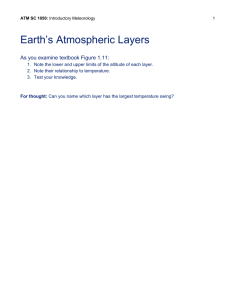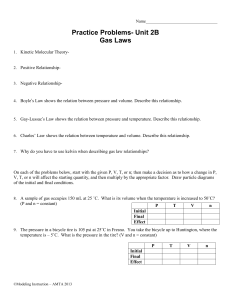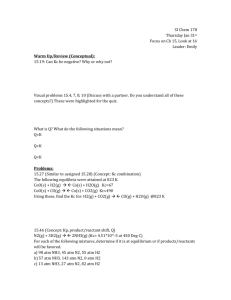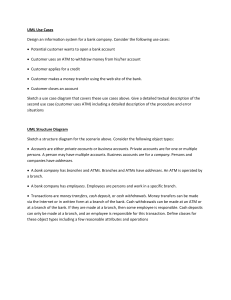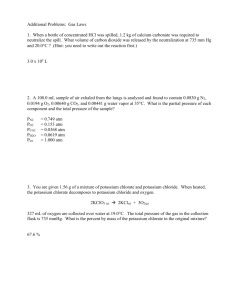ATM_Brochure_July201.. - Department of Atmospheric and
advertisement
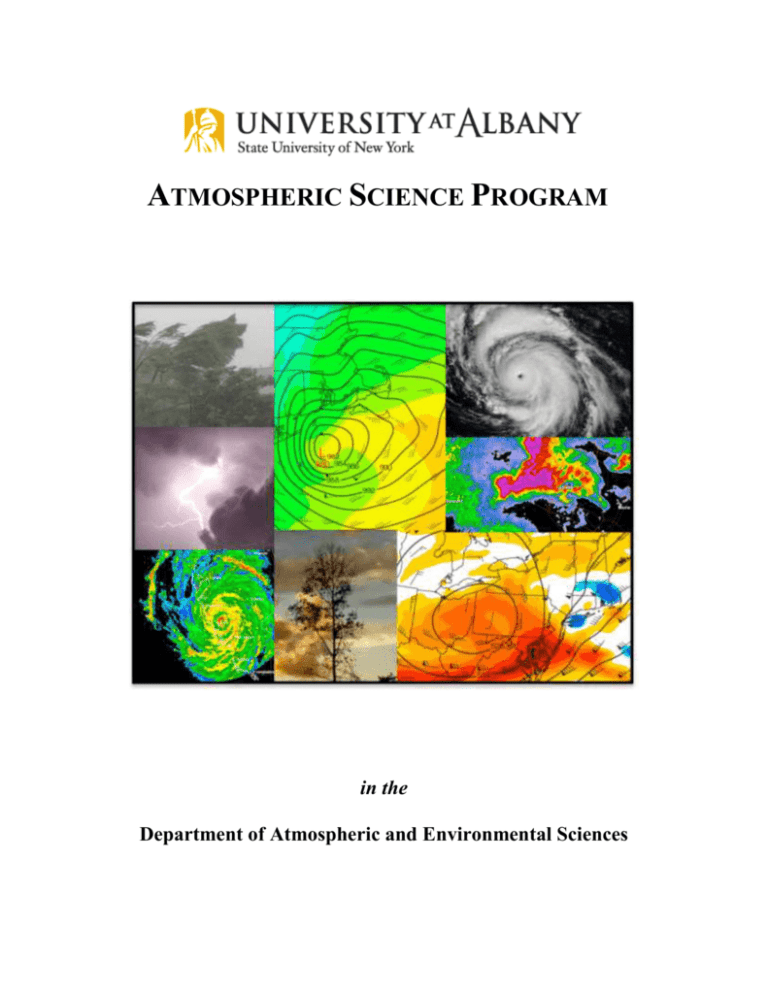
ATMOSPHERIC SCIENCE PROGRAM in the Department of Atmospheric and Environmental Sciences Bachelor of Science Degree in Atmospheric Science The Atmospheric Science program at the University at Albany is both nationally and internationally well-renowned. The combination of the Department of Atmospheric and Environmental Sciences (DAES) and the Atmospheric Sciences Research Center (ASRC) gives the University the largest program of education and research in the atmospheric sciences in New York State, and one of the largest in the nation. In addition, the National Weather Service’s regional office is collocated with ASRC on the main campus. This gives students in the department the unique opportunity to work closely with researchers and forecasters in multiple fields of study within the atmospheric sciences. The Atmospheric Science department was established in the early 1960s by Vincent Schaefer, the protégé of Nobel Laureate chemist Dr. Irving Langmuir. Inspired by Langmuir, Schaefer, a worldrenowned cloud physicist himself, discovered the method of cloud seeding that ushered in the science of weather modification. Thus began a tradition of prominent research in the field that continues today. The current group of scientists covers a broad range of interest in the atmospheric and environmental sciences. Topics of research and study include synoptic-dynamic meteorology, mesoscale meteorology, weather systems, hydrometeorology, short- and medium-range forecasting, hurricanes and tropical meteorology, climate and climate change, cloud and precipitation physics, atmospheric chemistry, air pollution, and bioclimatology. More detail on the specific areas of research of our faculty members can be found beginning on page 6. Research and teaching facilities are among the most advanced in the nation. The synoptic-dynamic program is supported by a fully equipped electronic map room with satellite, radar, observation, lightning detection, and model forecast data from around the world. This room is used for teaching and for weather discussions, the latter of which occur weekly at both a graduate and undergraduate level. The map room also serves as a lab with many Linux/Windows workstations. Students are free to use the room as a group or individual study area, or to hone their forecasting skills in one of the Atmospheric Science Map Room department’s several forecasting contests. In addition to excellent on-campus research laboratories, computer facilities and the map room, we operate several field stations. One such station, operated by ASRC, is atop Whiteface Mountain just north of Lake Placid, NY. This facility provides long-term observation of atmospheric chemical species, cloud properties, acid precipitation, aerosol content and other environmental parameter used in various ongoing projects. The department, along with ASRC, also runs an atmospheric observatory atop Mohawk Tower (Indian Quad), which commands a 360o view of the surrounding area. Whiteface Observatory operated by ASRC Photo from www.adirondackexplorer.org 2 Requirements for the B.S. Degree in Atmospheric Science Students planning to study atmospheric science should have a good academic preparation in physics and mathematics. Core courses related to the study of the atmosphere begin at the beginning of the sophomore year, although students are encouraged to take introductory courses not required for the major during their freshman year. A full list of courses offered in the department appears on Page 4. The Bachelor of Science (B.S.) in Atmospheric Science course requirements consists of a minimum of 66 credits for the combined major/minor, including: ATM 209: Weather Workshop ATM 210/Z: Atmospheric Structure, Thermodynamics and Circulation ATM 211: Weather Analysis and Forecasting ATM 316: Dynamic Meteorology I ATM 317: Dynamic Meteorology II ATM 320: Atmospheric Thermodynamics ATM 350: Meteorological Datasets and Numerical Computation ATM 418: Dynamic Meteorology III ATM 425Y: Physical Meteorology ATM: Twelve additional credits of ATM 301 or higher (excluding ATM 304), though no more than six can come from internships or research (ATM 490, 497, 498, 499) PHY 140 and 145: Physics I: Mechanics (and lab) PHY 150: Physics II: Electromagnetism PHY 240: Physics III: Structure of Matter MAT 111/112/118: Calculus I MAT 113/119: Calculus II MAT 214: Calculus III MAT 311: Ordinary Differential Equations CHM 120/130: General Chemistry I Although no minor is required for those majoring in Atmospheric Science, some students do choose to add an additional minor, or minors. Some common choices are Math, Physics, Chemistry, Computer Science, and Business. In addition, all atmospheric science majors are able to add a broadcast meteorology minor, which involves taking courses in journalism, as well as an internship with a broadcast meteorologist at a local television station. Some students also choose to “double major” with any of the aforementioned programs. The department also offers a Bachelor of Science degree in Environmental Science. This degree provides an interdisciplinary education while allowing for a concentration in one of three areas: Climate, Geography, or Biology. Additional information on the Environmental Science degree is given in a separate brochure. Photo by Rihaan Gangat, Class of 2011 Honors in the major: Students with a cumulative Grade Point Average (GPA) of at least 3.25 overall, and a 3.5 GPA in the major at the end of their fourth semester may apply for a B.S. with honors in atmospheric science. To be eligible for a degree with honors, students must also complete a total of 74 credits including two semesters of Undergraduate Research (ATM 499) leading to a significant undergraduate thesis. Further, the above GPAs must be maintained throughout the student’s education. The honors degree represents one of the most challenging programs on this campus; it is designed and intended for only the most exemplary students, but allows students great research opportunities with faculty in our department. 3 Typical B.S. Program in Atmospheric Science (Required courses in bold) Semester I MAT 112: Calculus I PHY 140, 145: Physics I (w/ lab) CHM 120: Chemistry I Elective/University Gen. Ed. Requirement Semester 3 MAT 214: Calculus III PHY 240: Physics III ATM 209: Weather Workshop ATM 210/Z: Atmospheric Structure, Thermodynamics, and Circulation Elective/Gen-ed Semester 2 MAT 113: Calculus II PHY 150: Physics II Elective/Gen-ed Elective/Gen-ed 4 4 4 * Semester 4 MAT 311: Differential Equations ATM 211: Weather Analysis and Forecasting Elective/Gen-ed Elective/Gen-ed Elective/Gen-ed 4 4 1 3 3 4 * * * * Semester 5 ATM 316: Dynamic Meteorology I ATM 311: Severe and Hazardous Weather ATM Elective Elective/Gen-ed Elective/Gen-ed 3 4 * * * Semester 7 ATM 418: Dynamic Meteorology III ATM 400: Synoptic Meteorology I ATM Elective/Gen-ed/Internship Elective/Gen-ed Elective/Gen-ed 3 3 * * * Semester 6 ATM 317: Dynamic Meteorology II ATM 320: Atmos. Thermodynamics ATM 350: Meteorological Datasets and Numerical Computation ATM Elective Elective/Gen-ed Semester 8 ATM 425Y: Physical Meteorology ATM 401: Synoptic Meteorology II ATM Elective/Gen-ed/Internship Elective/Gen-ed Elective/Gen-ed Available Undergraduate Courses in Atmospheric Science “Z” indicates a course that satisfies the “writing intensive” general education requirement ATM 100: ATM 101: ATM 102: ATM 107: ATM 200: ATM 209: ATM 210/Z: ATM 211: ATM 297: ATM 301: ATM 304/Z: ATM 305: ATM 306: ATM 307/Z: ATM 311: ATM 315: ATM 316: 4 3 * * The Atmosphere (3) The Upper Atmosphere (3) Science and Major Environmental Issues (3) The Oceans (3) Natural Disasters (3) Weather Workshop (1) Atmospheric Structure, Thermodynamics, and Circulation (3) Weather Analysis and Forecasting (4) Independent Study (1-3) Surface Hydrology and Hydrometeorology (3) Air Quality (3) Global Physical Climatology (3) Climate Variability and Change (3) Atmospheric Chemistry (3) Severe and Hazardous Weather (4) Environmental Statistics (3) Dynamic Meteorology I (3) (continued on next page) 4 3 3 2 * * 4 3 * * * ATM 317: ATM 320: ATM 327: ATM 335: ATM 350: ATM 400: ATM 401: ATM 408: ATM 409: ATM 414: ATM 418: ATM 421: ATM 424: ATM 425Y: ATM 480: ATM 490: ATM 497: ATM 498: ATM 499: Dynamic Meteorology II (3) Atmospheric Thermodynamics (3) Meteorological and Environmental Measurement (3) Meteorological Remote Sensing (3) Meteorological Datasets and Numerical Computation (2) Synoptic Meteorology I (3) Synoptic Meteorology II (3) Hydrometeorology (3) Atmospheric Precipitation Processes (3) Air Pollution (3) Dynamic Meteorology III (3) Tropical Meteorology (3) Fundamentals of Atmospheric Electricity (3) Physical Meteorology (4) Special Topics in Atmospheric Science (1-3) Internship in Atmospheric Science (1-3) Independent Study II (1-3) Computer Applications in Meteorological Research (1-3) Undergraduate Research (3) Undergraduate Internship and Research Opportunities Internships: All undergraduate students maintaining a GPA above 2.5 are eligible to participate in an internship at the National Weather Service (NWS) forecast office in Albany. As previously mentioned, the NWS is located on UAlbany’s campus, and only a ten minute walk from the department. As part of this internship, which is either done during a student’s junior or senior year (or the summer in between), students work closely with each member of the NWS office. Some of the responsibilities include launching weather balloons twice daily, collecting and disseminating atmospheric data, forecasting in the short- and medium-range for the Capital Region and surrounding areas, and even assisting in tornado or high wind damage surveys. By the end of the internship, students are qualified for paid intern positions at the NWS. Other internship opportunities can be arranged with local groups in the private sector of meteorology, such as AWS Truepower, MESO, and the Department of Environmental Conservation. Additionally, internships are available with the Atmospheric Science Research Center on our campus. Research: As previously mentioned, research is a requirement for those students pursuing an Honors degree in the major, but opportunities are also available for non-Honors students to work on research projects with faculty members in our department. In some cases, students work on a faculty member’s ongoing research project, but students are also encouraged to come up with their own ideas. More information on the types of research covered by our faculty can be found beginning on page 6. There are multiple forecast contests run in our department throughout the year, and students also participate in the national collegiate forecasting contest, WxChallenge. These opportunities allow our students to improve their forecasting skills for many different regions. 5 Graduate Program Our department also has an active graduate program, offering Ph.D. and M.S. degrees in atmospheric science. This program is viewed to be one of the top atmospheric science graduate departments in the country. A multitude of prominent research in atmospheric science has come from graduate work at UAlbany, and many of our graduates are now employed at some of the top research and teaching facilities in the world. Careers Many of our undergraduate degree recipients advance to graduate study. Others obtain employment in federal, state and local government agencies, university departments, research laboratories, and private industry. Some of the more common types of employment span the areas of: -Research -Teaching -Governmental regulation -Air quality monitoring -Weather forecasting (private sector, and NWS) -Radio and television broadcasting -Scientific and engineering consultation -Solar and wind energy development, and energy forecasting -Risk management -Finance/derivatives -Meteorological instrumentation (development and manufacturing) -Environmental legislation -Weather modification Additionally, an increasing number of graduates are being employed in the private sector via the unique combination of an undergraduate degree in atmospheric science with graduate education in disciplines such as business administration, management and public health. Faculty Research Interests Members of the Department of Atmospheric and Environmental Sciences are funded externally by agencies such as the National Science Foundation (NSF), the National Aeronautics and Space Administration (NASA), the Office for Naval Research (ONR), the National Oceanic and Atmospheric Administration (NOAA), the Air Force Office for Science Research (AFOSR) and others. Several faculty members have recently served as either an editor or associate editor for some of the premier scientific journals in the field. Special recognition has come to some of our faculty members as winners of prestigious awards from the American Meteorological Society (AMS) in recognition of outstanding achievement in the field. Dr. Daniel Keyser received the Meisinger Award (1989), Dr. Lance Bosart garnered the Jule G. Charney Award (1992) and was the inaugural recipient of the Teaching Excellence Award (2001), while Dr. John Molinari received the Banner I. Miller Award (1999). Dr. Bosart, a Distinguised Professor, also is an Affiliate Scientist with the National Center for Atmospheric Research (NCAR) in Boulder, Colorado. (continued on next page) 6 Faculty Research Interests, Continued Synoptic (Weather Systems) and Mesoscale Meteorology, and Hydrometeorology Dr. Lance Bosart Dr. Kristen Corbosiero Dr. Daniel Keyser Dr. Andrea Lang Dr. Justin Minder Dr. Ryan Torn Climatology/Climate Change/Paleoclimatology Dr. Aiguo Dai Dr. Jiping Liu Dr. Mathias Vuille Dr. Liming Zhou Hurricanes and Tropical Meteorology Dr. Lance Bosart Dr. Kristen Corbosiero Dr. John Molinari Dr. Paul Roundy Dr. Brian Tang Dr. Christopher Thorncroft Dr. Ryan Torn Physical Meteorology Dr. Vince Idone Dr. Justin Minder Atmospheric Chemistry Dr. Robert Keesee Contact information Department of Atmospheric and Environmental Sciences http://www.atmos.albany.edu University at Albany, ES-351 1400 Washington Ave., Albany, NY 12222 Phone: (518)-442-4556 E-mail: chair@atmos.albany.edu National Weather Service Forecast Office: Albany, New York Mr. Raymond O’Keefe, Meteorologist-in-charge Center for Environmental Sciences and Technology Management (CESTM) 251 Fuller Rd., Suite B300, Albany, NY 12203 Phone: (518)-435-9566 E-mail: Raymond.Okeefe@noaa.gov 7 Department of Atmospheric and Environmental Science Faculty Lance F. Bosart, Distinguished Professor (Ph.D., MIT) ES-227, (518)-442-4564 lbosart@albany.edu Justin R. Minder, Assistant Professor (Ph.D., Univ. of Washington), ES-339B John E. Molinari, Professor (Ph.D., Florida State Univ.) ES-225, (518)-442-4562 jmolinari@albany.edu Kristen Corbosiero, Assistant Professor (Ph.D., Univ. at Albany) ES-321, (518)-442-5852 kcorbosiero@albany.edu Paul E. Roundy, Assistant Professor (Ph.D., Pennsylvania State Univ.) ES-339A, (518)-442-4476 proundy@albany.edu Vincent P. Idone, Associate Professor (Ph.D., Univ. at Albany) ES-215, (518)-442-4577 vidone@albany.edu Brian H. Tang, Assistant Professor (Ph.D., MIT) ES-324, (518)-442-4572 Robert G. Keesee, Associate Professor (Ph.D., Univ. of Colorado) ES-214, (518)-442-4566 rkeesee@albany.edu Christopher D. Thorncroft, Professor and Department Chair (Ph.D., Univ. of Reading) ES-226, (518)-442-4555 cthorncroft@albany.edu Daniel Keyser, Professor (Ph.D., Pennsylvania State Univ.) ES-224, (518)-442-4559 dkeyser@albany.edu Ryan Torn, Assistant Professor (Ph.D., Univ. of Washington) ES-229, (518)-442-4560 rtorn@albany.edu Michael Landin, Instructor (M.S., Univ. at Albany) ES-324, (518)-442-4572 mlandin@albany.edu Kevin R. Tyle, Systems Administrator (M.S., Univ. at Albany) ES-235A, (518)-442-4578 ktyle@albany.edu Andrea L. Lang, Assistant Professor (Ph.D., Univ. of Wisconsin) ES-323, (518)-442-4558 alang@albany.edu Mathias Vuille, Associate Professor (Ph.D., Univ. of Bern) ES-311, (518)-442-4472 mvuille@albany.edu Ross A. Lazear, Instructional Support Specialist (M.S., Univ. of Wisconsin) ES-322, (518)-437-3601 rlazear@albany.edu Liming Zhou, Associate Professor (Ph.D., Boston University) ES-312, (518)-442-4446 lzhou@albany.edu Jiping Liu, Assistant Professor (Ph.D., Columbia University), ES-210 8


